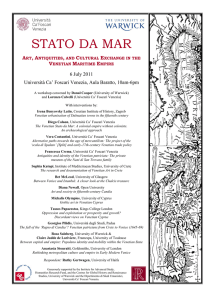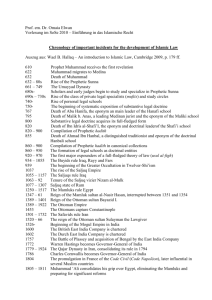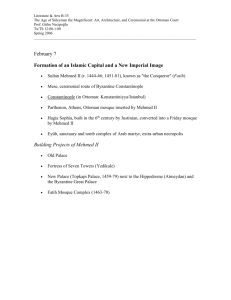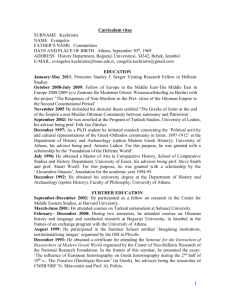Proposal for the 3rd MMHN Conference
advertisement
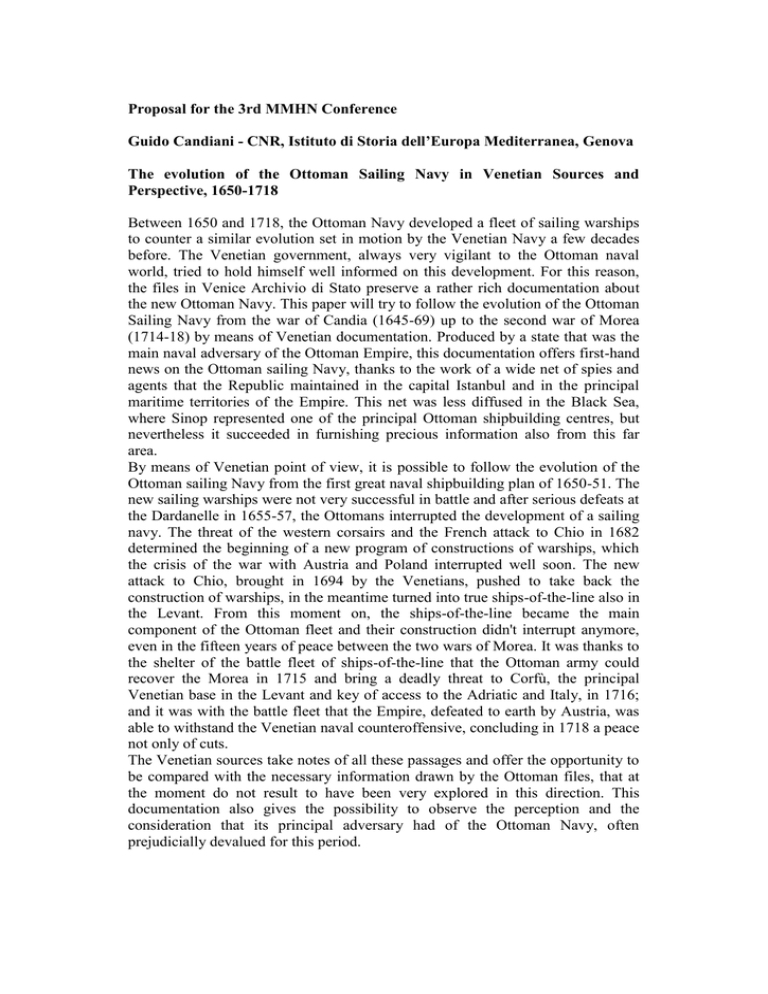
Proposal for the 3rd MMHN Conference Guido Candiani - CNR, Istituto di Storia dell’Europa Mediterranea, Genova The evolution of the Ottoman Sailing Navy in Venetian Sources and Perspective, 1650-1718 Between 1650 and 1718, the Ottoman Navy developed a fleet of sailing warships to counter a similar evolution set in motion by the Venetian Navy a few decades before. The Venetian government, always very vigilant to the Ottoman naval world, tried to hold himself well informed on this development. For this reason, the files in Venice Archivio di Stato preserve a rather rich documentation about the new Ottoman Navy. This paper will try to follow the evolution of the Ottoman Sailing Navy from the war of Candia (1645-69) up to the second war of Morea (1714-18) by means of Venetian documentation. Produced by a state that was the main naval adversary of the Ottoman Empire, this documentation offers first-hand news on the Ottoman sailing Navy, thanks to the work of a wide net of spies and agents that the Republic maintained in the capital Istanbul and in the principal maritime territories of the Empire. This net was less diffused in the Black Sea, where Sinop represented one of the principal Ottoman shipbuilding centres, but nevertheless it succeeded in furnishing precious information also from this far area. By means of Venetian point of view, it is possible to follow the evolution of the Ottoman sailing Navy from the first great naval shipbuilding plan of 1650-51. The new sailing warships were not very successful in battle and after serious defeats at the Dardanelle in 1655-57, the Ottomans interrupted the development of a sailing navy. The threat of the western corsairs and the French attack to Chio in 1682 determined the beginning of a new program of constructions of warships, which the crisis of the war with Austria and Poland interrupted well soon. The new attack to Chio, brought in 1694 by the Venetians, pushed to take back the construction of warships, in the meantime turned into true ships-of-the-line also in the Levant. From this moment on, the ships-of-the-line became the main component of the Ottoman fleet and their construction didn't interrupt anymore, even in the fifteen years of peace between the two wars of Morea. It was thanks to the shelter of the battle fleet of ships-of-the-line that the Ottoman army could recover the Morea in 1715 and bring a deadly threat to Corfù, the principal Venetian base in the Levant and key of access to the Adriatic and Italy, in 1716; and it was with the battle fleet that the Empire, defeated to earth by Austria, was able to withstand the Venetian naval counteroffensive, concluding in 1718 a peace not only of cuts. The Venetian sources take notes of all these passages and offer the opportunity to be compared with the necessary information drawn by the Ottoman files, that at the moment do not result to have been very explored in this direction. This documentation also gives the possibility to observe the perception and the consideration that its principal adversary had of the Ottoman Navy, often prejudicially devalued for this period. CV Guido CANDIANI, born in Milan (ITALY), August 6, 1959 "Laurea" in History, University of Venice, 1988, tutor Prof. Marino Berengo Two years fellowship at "Fondazione G. Cini" of Venice, September 1999-August 2001 Doctorate in Modern and Contemporary History at University of Paris IV-La Sorbonne, October 2003-… tutor Prof . Lucien Bély. Researcher at Genoa center of the Institute of the European Mediterranean History, September 2009-… Books I vascelli della Serenissima: guerra, politica e costruzioni navali a Venezia in età moderna, 1650-1720, Venezia 2009. Principal Articles Francia, Papato e Venezia nella fase finale della guerra di Candia, in «Atti dell'Istituto Veneto di Scienze, Lettere ed Arti», CLII, 1993-94, pp. 829-872. Conflitti d’intenti e di ragioni politiche, di ambizioni e di interessi nel patriziato veneto durante la guerra di Candia, in «Studi Veneziani», N.S., XXXVI, 1998, pp. 145-275. Tiburzio Bailo e i cannoni di Sarezzo. Politica navale e forniture militari nella Repubblica di Venezia durante la prima guerra di Morea (1684-99), in «Società e Storia», 102, 2003, pp. 677-706. La gestione degli equipaggi nei vascelli veneziani tra Sei e Settecento, in Militari in Età Moderna. La centralità di un tema di confine, a cura di A. Dattero e S. Levati, Milano 2006, pp. 171-195. Galee forzate o di libertà: una comparazione tra la marina veneziana e quella spagnola all’indomani della contesa dell’Interdetto (1607), in Guerra y sociedad en la Monarquía Hispánica. Politica, Estrategia y Cultura en la Europa Moderna (1500-1700), ed. E. García Hernán-D. Maffi, Madrid 2006, I, pp. 947964. Stratégie et diplomatie vénitiennes, navires angle-hollandaises : le blocus des Dardanelles, 1646-1659, in «Revue d’Histoire Maritime», 9 (2008), pp. 251282.
